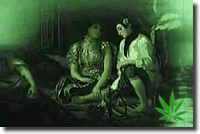About Marijuana
- Types of Marijuana
- Marijuana Effects
- Facts About Marijuana
- Smoking Marijuana
- Dangers of Marijuana
- Marijuana Side Effects
- Marijuana Addiction
- Signs of Marijuana Addiction
- Marijuana Withdrawal
- Marijuana Addiction Treatment
- Marijuana History
- Marijuana Statistics
- Marijuana Laws
- Medical Marijuana
- Teen Marijuana Use
- Signs of Marijuana Use
- Marijuana Legalization
- Cannabis
- Cost of Marijuana
- Marijuana Slang Terms
- Marijuana Pictures

Marijuana History
 Marijuana history and reference to the hemp plant (cannabis) appears as early as 2700 B.C. in a Chinese manuscript. European explorers arriving to the New World first observed the plant in 1545. It was considered to be such an useful crop that early Jamestown settlers in 1607 began its cultivation and later, in Virginia, farmers were fined for not growing hemp. In 1617, it was introduced into England. From the seventeenth to the mid-twentieth century marijuana was considered a household drug useful for treating such maladies as headaches, menstrual cramps, and toothaches. From 1913-38 a stronger variety of the marijuana plant was cultivated by American drug companies for use in their drug products. It was called Cannabis americana.
Marijuana history and reference to the hemp plant (cannabis) appears as early as 2700 B.C. in a Chinese manuscript. European explorers arriving to the New World first observed the plant in 1545. It was considered to be such an useful crop that early Jamestown settlers in 1607 began its cultivation and later, in Virginia, farmers were fined for not growing hemp. In 1617, it was introduced into England. From the seventeenth to the mid-twentieth century marijuana was considered a household drug useful for treating such maladies as headaches, menstrual cramps, and toothaches. From 1913-38 a stronger variety of the marijuana plant was cultivated by American drug companies for use in their drug products. It was called Cannabis americana.
Without the hemp plant, one of the oldest psychoactive plants around, there would be no marijuana history to write about. The dried leaves of the hemp plant have been inhaled and ingested for centuries. Marijuana changes an user’s mood, perception, and consciousness. For most of marijuana history, hemp and its by-products have been legal. Here are a few captivating specifics about the history of marijuana:
- Marijuana use as medicine was first recorded in history as far back as 2727 B.C. by the Chinese Emperor Shen Nung. He documented its medical effectiveness in treating rheumatism, gout, and even absent-mindedness.
- Queen Victoria of England was prescribed cannabis for menstrual cramps by her personal physician Sir Russell Reynolds. He wrote in the first issue of The Lancet in 1890 that “when pure and administered carefully, cannabis is one of the most useful medicines we possess.”
- America’s first marijuana law was not, as many might imagine, to ban the growing of the plant. Marijuana history shows that it was just the opposite. Back in 1619, the farmers of the Jamestown Colony in Virginia were “ordered” to grow hemp crops. This was the first of many such laws. Also, between 1763 and 1767, not growing the hemp plant could get a farmer thrown in jail.
- The reason that hemp farming was encouraged was so very different from the reasons that many people try to grow it today. Back then, the hemp plant had much more practical uses. Once harvested, it was turned into clothing, sails, and rope.
- Marijuana history shows that hemp was once considered legal tender in the United States, even accepted by the government as a payment for your taxes.
- Major General George Washington, U.S. Revolutionary War hero and first president of the United States, cultivated Indian Hemp (Cannabis sativa indica, i.e. medical cannabis, which could also be used for fiber, although not as well as regular hemp) on his farm. "Make the most you can of the Indian hemp seed. Sow it everywhere." -- George Washington, in a letter to his farm manager.
- Visitors to the 1876 American Centennial Exposition in Philadelphia were invited to “toke up” at the Turkish Hashish Exposition stand
- In the 1890s, marijuana history reveals that several women’s temperance societies actually recommended the use of hashish instead of alcohol. Their reasoning: liquor led to domestic violence, whereas hashish did not.
- Prior to 1910, the growth and trade of marijuana (and hashish—a resinous substance produced by the flowering parts of the plant) was fairly limited. However, following the conclusion of the Mexican Revolution, trafficking of the drug opened up, making growth and transport of the drug easier and more profitable. The business expanded to reach the ports of New Orleans where it was sold on the black market, alongside other strains of the plant, to sailors passing through, as well as local residents. It wasn't long before the trend of marijuana use began to overshadow the historic applications of cannabis as a medicine.
- The drug soon became popular (especially its stronger derivatives—hashish, charas, ghanja, and bhang) among musicians who maintained that smoking marijuana gave them the inspiration they needed to play their music. These musicians glamorized the use of marijuana. Some claimed it gave them contemplative vision and a feeling of overwhelming freedom and verve; others not only used the drug themselves, but sold it to a variety of customers. As the entertainers went on the road, so did their drugs. Eventually, use of marijuana, alcohol, and other mind-altering drugs spread and soon became prevalent in major cities worldwide, such as Chicago, New York, London, and Paris.
- Marijuana history shows that many of the musicians and entertainers of the Jazz Age who used drugs and alcohol relied heavily on gangland kings for their "gigs" (jobs). Frequently, these gangsters were able to provide (for a fee) a variety of drugs and bootleg alcohol for the performers and their staffs.
- Up until the 1940’s, marijuana was easily obtained at the local general store or pharmacy. Used as a medicine, it was listed in the United States Pharmacopoeia as useful for medical conditions such as nausea, rheumatism, and labor pain. It was subsequently removed from the pharmacopoeia in 1942 when it was decided that marijuana was a harmful and addictive drug, causing psychotic episodes.
